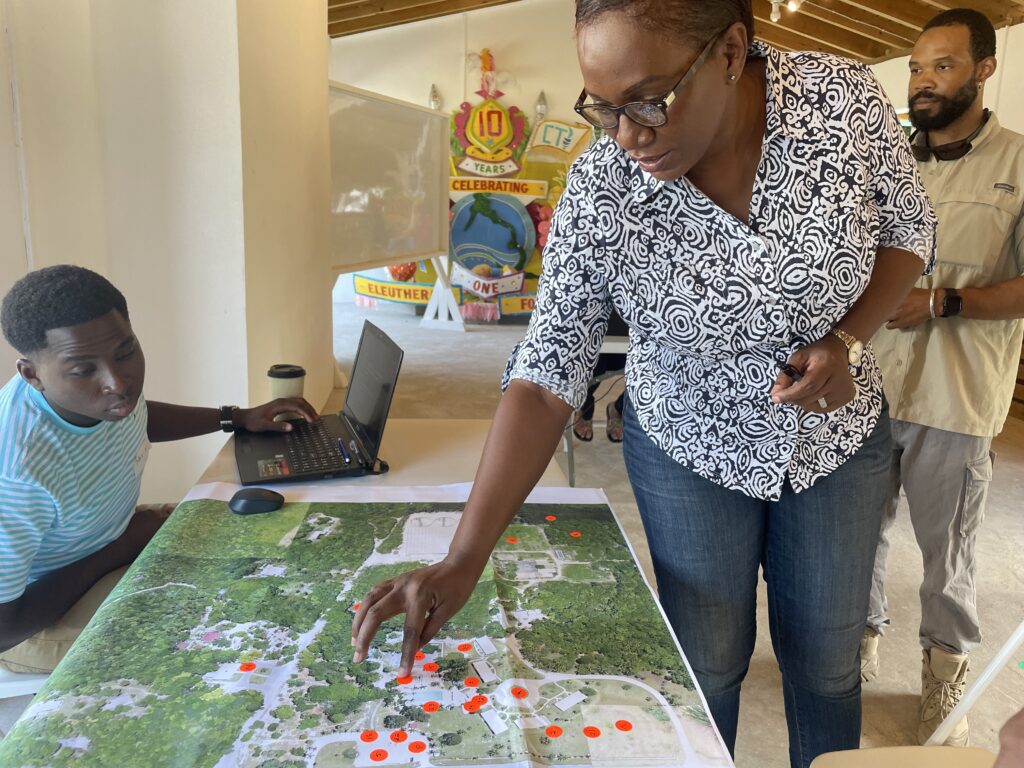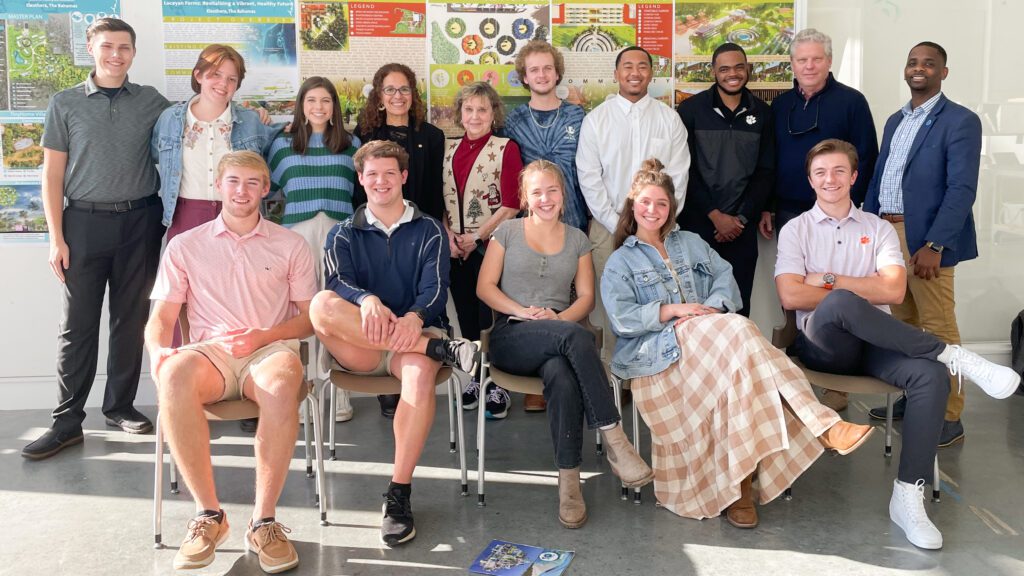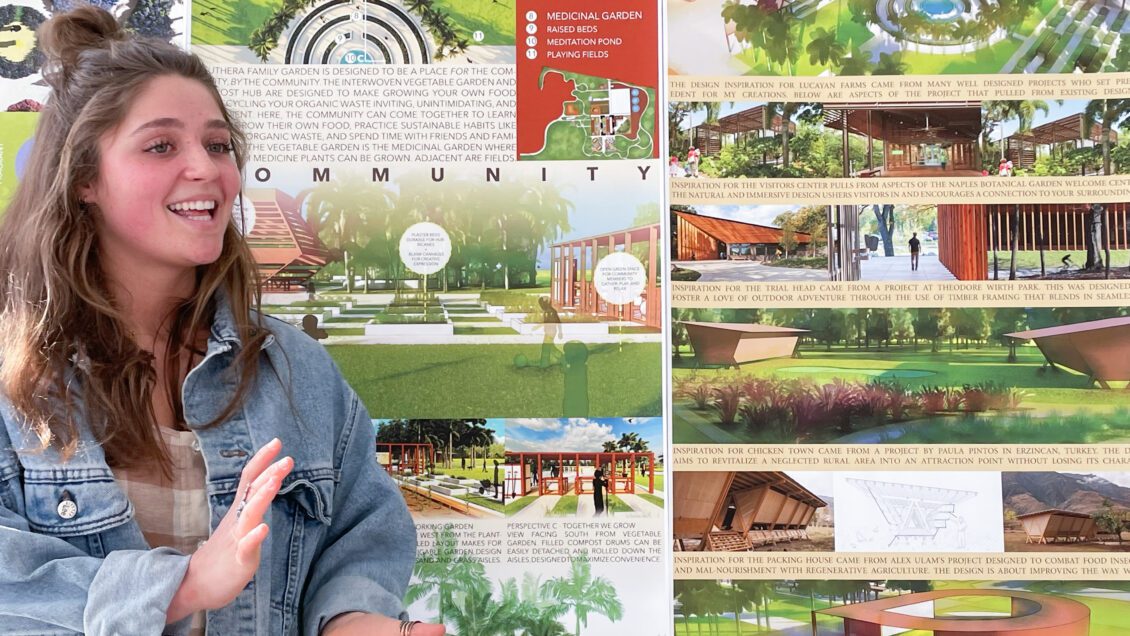The island of Eleuthera in the Bahamas has many attractive features—pink sand beaches, coral reefs, a rich culture—and one huge challenge: self-sustainability. Recently, Clemson University landscape architecture students partnered with the non-profit One Eleuthera Foundation (OEF) to design a vision for a sustainable future.
The undergraduate landscape architecture studio led by Professor Hala Nassar in Fall 2022 created a master plan for One Eleuthera Foundation’s proposed Centre for Training and Innovation (CTI).
Nassar noted that while Eleuthera’s economy thrived in the first half of the 20th century, between 1965 and 1995, tourism and agriculture began to decline. In 2019, Hurricane Dorian dealt a blow with devastating damage and flooding.
“As these changes continue to threaten the local economy and environment, the island is exploring methods to adapt and enhance climate resiliency,” Nassar said.
Community-based solutions
One Eleuthera Foundation currently owns a small resort hotel called “The Retreat” and several surrounding acres of farm and woodland, with a vision for more.
“We envision developing a world-class training campus that supports our community development work,” said Keyron Smith, One Eleuthera Foundation’s chief operating officer.
Nassar, who has been familiar with the organization for more than a decade, saw a service-learning opportunity for her undergraduate landscape architecture studio to work on a master plan for the site. The students’ designs focus on four areas: the hotel, the farm, a community center, and a CTI campus.
I was amazed by the quality of work, their presentations, and the meticulous effort these students put into designing different areas of our campus.
Keyron Smith, One Eleuthera Foundation
“The School of Architecture is excited to work with the One Eleuthera Foundation,” said Jim Stevens, director of the Clemson University School of Architecture. “Allowing students to study ecological challenges and design solutions in different parts of the world gives them insights they bring back to Clemson and the state of South Carolina.”
Before the design process could begin, however, Clemson’s students needed to garner community feedback, which wasn’t possible to do in person.
“Being able to visit your site is a huge part of the analysis and planning in the design process,” said Shelbie Hyland, a second-year landscape architecture major. “This was definitely a big challenge for us.”
Thankfully, landscape architecture students at the University of The Bahamas stepped up to conduct the feedback sessions, and the partnership paid dividends.

“I felt a sense of connection and pride to the designs and was proud of how the students portrayed the feedback they received,” Smith said.
Technology-enhanced design
Hyland’s portion of the project focused on the farm, which currently features a 1.1 acre state-of-the-art solar-powered, hurricane-resistant greenhouse called the OASIS. She designed a plan for the acreage surrounding the greenhouse to include a visitor’s center, outdoor classroom, medicinal garden, edible forest and more.






“The climate is different, the vegetation is different, the economy is different, and the design needs are different,” she observed. “It was such a fun experience getting to know the island in every way in order to create designs that would truly be for the community of Eleuthera.”
Hyland also noted that the project was an opportunity to explore and learn new digital rendering software, which she said “massively” elevated her work.
A perfect example of how technology enhanced the students’ designs can be seen in a short video produced by Andrew Poole, which presents a fully-animated 3D rendering of his master plan design for the new CTI campus.
In each design, students incorporated local culture and vegetation with the goal of not only improving the look of the site, but of supporting a sustainable community. Nassar, who has been teaching landscape architecture for more than 25 years, said that the studio’s completed projects were some of the best student work she had ever directed.
“For students to do this level of design in their second year of college is truly impressive,” she said.
In December 2022, students presented their designs to One Eleuthera Foundation, and the reaction was ecstatic.
“I was stunned when I saw the phenomenal designs created by the students,” Smith said. “I was amazed by the quality of work, their presentations, and the meticulous effort these students put into designing different areas of our campus.”
For One Eleuthera Foundation, the plans are a launching point for future site development and fundraising. For the students, it provided a new perspective on launching their careers.
“I had no idea how important and powerful our work can be for not just individuals, but entire communities,” Hyland said. “It makes the work that much more rewarding when you can see how impactful your design can be to so many others.”

Get in touch and we will connect you with the author or another expert.
Or email us at news@clemson.edu

